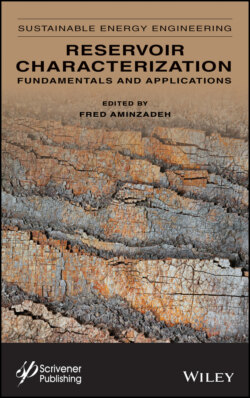Читать книгу Reservoir Characterization - Группа авторов - Страница 44
3.1 Introduction
ОглавлениеAn anomaly detection problem arises in geological research and reservoir characterization when, for example, there is a need to locate gas-filled sands in the vicinity of the area with identified brine-filled sands or shales, Katz et al., [8]. Other examples of anomaly detection problems include finding the location of an overpressure zone using data obtained from an area with normal gas pressure Dvorkin et al., [6], Gurevich et al., [7] and finding the location of fractured carbonates filled with gas, Chilingar et al., [5], Maity and Aminzadeh [12].
Detection of anomalous behavior in seismic and/or well log data, which can be attributed to the presence of hydrocarbon, has been the subject of many research activities. Seismic attributes introduced by Taner [16] have been widely used to detect seismic anomalies. Subsequently, many methods have been used to combine such attributes, either through clustering, Aminzadeh and Chaterjee [10], or neural networks Aminzadeh et al., [13]. Then, the meta attributes concept was introduced which combines machine and human intelligence for a targeted anomaly detection Aminzadeh [11‒15]. For a comprehensive overview of seismic attribute methodologies see Chopra and Murfurt [17].
The methodology for anomaly detection (AD) presented in this paper is different from multiclass classification where a training set is formed as a union of several subsets, and each subset contains records from a single class. Records from all classes are mixed in the training set. It is also different from the classical methodology for outlier detection. Outlier detection methodology is aimed at analysis of a dataset that may contain both regular and outlier records which are not identified prior to outlier analysis, so there is no training set (Barnett [2], Barnett and Lewis [3], Agrawal and Raghavan [1], Breunig et al. [4]).
In this paper writers tested new algorithms that belong to the group of one-class classification machine learning techniques. One-class classification is a comparatively new area of machine learning research (see for example Tax and Duin [18], Muñoz-Marí [19], Marti et al. [24]). Machine learning one-class classification methodology presented in this paper has several advantages compared to outlier detection. This methodology is model-free and all anomaly detection decisions are based on the use of a value of expected false discovery rate. The main advantage of this methodology is its ability to work efficiently with training sets of moderate size.
Three basis AD classifiers are tested in this paper for identification of geologic anomalies: (a) distance in multi-dimensional space from-the-center of the training set, (b) sparsity of neighbors from the training set in the vicinity of a tested record, and (c) Bregman type divergence from the center of the training set. Distance and sparsity classifiers are universal techniques. To apply them for anomaly detection one does not need prior information about properties of a possible anomaly. Divergence is a highly specialized AD classifier that takes into account differences in properties of petrophysical parameters in a regular geologic area and those within a potential anomaly. Universal classifiers were used in this paper for construction of adaptive aggregated classifiers which structure is automatically modified according to the estimated properties of the studied anomaly of unknown type.
The writers used data on compression (Vp), shear (Vs) waves velocities, and rock density ρ for various geologic conditions presented by Ramos and Castagna [9]. Their dataset contains a total of 75 measurements of Vp, Vs, and density ρ for gas-filled sands, brine-sands, and shales. There are a total of 75 triplets (Vp, Vs, ρ) in their dataset. Part of brine-filled sands and shales data was used in this paper for construction of multiple bootstrap-generated training sets, whereas test sets included a combination of records from gas-filled and brine-filled sands, and shales.
